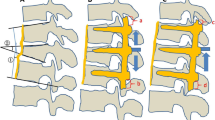Abstract
Objective
To examine disc degeneration at levels adjacent and next adjacent to the fractured vertebra and to analyses, if the disc degeneration is determined by the endplate fracture.
Summary of background data
Thoracolumbar burst fracture is one of the most common spinal injuries. The diagnostic (clinical and imaging) approach and treatment of a fractured vertebra is well established; however, some controversy remains. The associated disc degeneration is less well known after 9–12 months of the short segment pedicle screw fixations. There is a major controversy whether spinal trauma with vertebral endplate fractures can result in posttraumatic disc degeneration. No study to date, however, has assessed disc degeneration of the AO type A3 thoracolumbar fractures without neurologic deficits after pedicle screw fixations.
Methods
Twenty-six patients with single-level AO type A3 thoracolumbar fractures and no neurological deficit were treated by using postural reduction and short segment percutaneous pedicle screw fixation. No laminectomy and fusion were performed. Implants were removed 9–12 months after the first operation. The thoracolumbar magnetic resonance imaging (MRI) was used to assess disc degeneration at levels adjacent and next adjacent to the fractured vertebra before the first operation and after the second operation in a retrospective study.
Results
After the instrumentation removal, new disc degeneration was usually found at level adjacent to the cranial endplate of fractured vertebra by MRI examination in 24 patients. The average Pfirrmann grade of degenerative discs adjacent to the cranial fractured endplates deteriorated from 2.1 pre-operatively to 3.4 after the second operation. No change of disc degeneration was seen at the caudal disc space adjacent to the fractured vertebra and the levels next adjacent to the fractured vertebra. The discs next adjacent to the fractured vertebra were showed to be relatively normal without changes of degeneration during the study period.
Conclusions
Disc degeneration usually occurs at level adjacent to the fractured endplate of thoracolumbar burst fractures. Endplate fracture is strongly associated with disc degeneration. No correlation between fixation level and disc degeneration is seen in this study.


Similar content being viewed by others
References
Denis F (1983) The three column spine and its significance in the classification of acute thoracolumbar spinal injuries. Spine 8:817–831
Esses SI, Botsford DJ, Kostuik JP (1990) Evaluation of surgical treatment for burst fractures. Spine 15:667–673
Kraemer WJ, Schemitsch EH, Lever J et al (1996) Functional outcome of thoracolumbar burst fractures without neurologic deficit. J Orthop Trauma 10:541–544
Muller U, Berlemann U, Sledge J et al (1999) Treatment of thoracolumbar burst fractures without neurologic deficit by indirect reduction and posterior instrumentation: bisegmental stabilization with monosegmental fusion. Eur Spine J 8:284–289
Dai LY, Jiang SD, Wang XY et al (2007) A review of the management of thoracolumbar burst fractures. Surg Neurol 67:221–231
Oner FC, Rob R, van der Rijt RR, Ramos LM et al (1998) Change in the disc space after fractures of the thoracolumbar spine. J Bone Joint Surg Br 80:833–839
Kerttula LI, Serlo WS, Tervonen OA et al (2000) Post-traumatic findings of the spine after earlier vertebral fracture in young patients: clinical and MRI study. Spine 25:1104–1108
Pfirrmann CW, Metzdorf A, Zanetti M et al (2001) Magnetic resonance classification of lumbar intervertebral disc degeneration. Spine (Phila Pa 1976) 26:1873–1878
Cheh G, Bridwell KH, Lenke LG et al (2007) Adjacent segment disease following lumbar/thoracolumbar fusion with pedicle screw instrumentation: a minimum 5-year follow-up. Spine 32:2253–2257
Hsu K, Zucherman J, Shea W et al (1990) High lumbar disc degeneration. Incidence and etiology. Spine 15:679–682
Bostman O, Vornanen M, Keto P, Myllynen P (1993) The integrity of intervertebral disks after operative treatment of thoracolumbar fractures. Clin Orthop Relat Res 297:150–154
Kokkonen SM, Kurunlahti M, Tervonen O et al (2002) Endplate degeneration observed on magnetic resonance imaging of the lumbar spine: correlation with pain provocation and disc changes observed on computed tomography diskography. Spine 27:2274–2278
Holm S, Holm AK, Ekstrom L et al (2004) Experimental disc degeneration due to endplate injury. J Spinal Disord Tech 17:64–71
Przybyla A, Pollintine P, Bedzinski R et al (2006) Outer annulus tears have less effect than endplate fracture on stress distributions inside intervertebral discs: relevance to disc degeneration. Clin Biomech 21:1013–1019
Zhao FD, Pollintine P, Hole BD et al (2009) Vertebral fractures usually affect the cranial endplate because it is thinner and supported by less-dense trabecular bone. Bone 44:372–379
Urban JP, Smith S, Fairbank JC (2004) Nutrition of the intervertebral disc. Spine 29:2700–2709
Conflict of interest
None.
Ethical standard
The clinical study proposal was approved by the medical ethical committee of the authors’ institution. The written informed consents were obtained from all patients at study entry.
Author information
Authors and Affiliations
Corresponding author
Rights and permissions
About this article
Cite this article
Wang, J., Zhou, Y., Zhang, Z.F. et al. Radiological study on disc degeneration of thoracolumbar burst fractures treated by percutaneous pedicle screw fixation. Eur Spine J 22, 489–494 (2013). https://doi.org/10.1007/s00586-012-2462-1
Received:
Revised:
Accepted:
Published:
Issue Date:
DOI: https://doi.org/10.1007/s00586-012-2462-1




